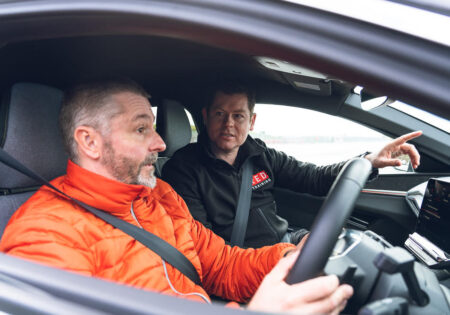Why Driver Training is essential for Fleet Safety
29 October, 2025
News Feature as appeared in Essential Fleet Manager magazine (Sept 2025). Click here for the full version.
Essential Fleet Manager Magazine recently interviewed Colin Paterson, Head of Marketing at RED Corporate Driver Training, to discuss the crucial role of structured driver training in managing fleet risk and preventing incidents. Colin explained how ongoing education can help improve driver performance, reduce collisions, and ensure organisations meet their legal duty of care—especially as fleets adapt to evolving technologies and road conditions.
Interview
Q: Why is driver training more important than ever for fleets?
Because vehicles alone don’t prevent accidents—drivers do. Regardless of how advanced or well-maintained a fleet is, safety ultimately depends on driver behaviour. Even experienced drivers can develop complacent or risky habits over time. Structured training highlights those behaviours, corrects them, and promotes a safer, more consistent approach to driving.
Q: What types of incidents can driver training help prevent?
The most common types are rear-end collisions, low-speed manoeuvres, and crashes caused by distraction or fatigue. Training helps drivers sharpen core skills like observation, hazard perception, anticipation, and spatial awareness. It also reinforces vital habits related to speed management and smooth braking. While these changes may seem minor, they collectively greatly reduce the likelihood of incidents on the road.
Q: How does RED’s training specifically support incident prevention?
Our programmes are tailored to address the specific needs of each fleet. This includes in-vehicle assessments, defensive driving training, and scenario-based coaching on how to respond safely under pressure. We also focus on driver mindset and behavioural factors, such as stress, complacency, and decision-making, which are often overlooked but crucial for long-term risk reduction. The aim is to develop not only skills but also awareness and confidence.
Q: Are there measurable outcomes from this kind of training?
Absolutely. Fleets consistently report reductions in incident rates and insurance claims after implementing training. Many also experience lower vehicle downtime, reduced maintenance costs, and improved driver morale. The impact is both operational and financial—enhancing safety while supporting the bottom line.
Q: What role does driver training play in compliance?
A crucial point. Under Health and Safety at Work legislation, employers are legally responsible for ensuring that anyone driving for work is competent to do so. That includes company cars, vans, leased vehicles, and grey fleet drivers. Structured training not only develops that competence but also creates an auditable record showing the business has taken proactive steps to manage risk. It’s a key part of meeting duty of care requirements.
Q: As more fleet operators electrify their fleets, does driver training need to evolve—and does RED offer EV-specific training?
Transitioning to electric vehicles is more than just swapping the engine; it requires a different approach behind the wheel. Drivers often carry over assumptions from petrol or diesel vehicles that don’t apply to EVs. That can lead to inefficiencies and, in some cases, avoidable safety risks.
One of the most common issues is range anxiety. Drivers may misunderstand real-world range versus advertised figures or miscalculate how much range they need. Regenerative braking can also confuse—some drivers don’t fully understand its impact on stopping distances or how to use eco modes and preconditioning features effectively.
To support this transition, we offer a full-day EV Familiarisation course. It’s a practical, hands-on programme that covers everything from vehicle setup and energy-efficient driving techniques to charging infrastructure and cable types. We tailor each course to the fleet’s specific operating environment, whether it’s grey fleet or field service drivers, leaving them with the knowledge and confidence to get the best out of their EVs while staying safe.
Q: Are there tangible benefits for fleet operators who invest in EV training?
Yes, without question. Fleets typically see a 10–15% boost in energy efficiency after training, which means greater range, less time spent charging, and smoother day-to-day operations. There’s also a marked reduction in range-related stress and a drop in avoidable incidents, particularly for drivers operating electric vans on tight schedules. Over time, that translates to lower costs, better vehicle uptime, and a more confident workforce.
Q: Some fleets still view training as a ‘nice-to-have’. What would you say to them?
That mindset often changes after a serious incident. The cost of even one collision, factoring in repairs, downtime, insurance, and reputational damage, can far exceed the cost of a comprehensive training programme. If you’re relying solely on driver experience and hoping for the best, you’re taking on unnecessary risk. A single day of training can prevent incidents, save money, and protect lives. That’s not a ‘nice-to-have’—it’s essential.
Q: Any advice for fleet managers looking to improve their driver safety culture?
Start by assessing your current situation, review incident reports, analyse near-miss data, and gather driver feedback. You should make sure this includes grey fleet drivers. Then build a proactive, long-term safety strategy that includes regular training, not just one-off sessions. The most successful fleets are those that treat safety as a continuous improvement process, not a checkbox exercise. Regular communication with your drivers (and their managers) is critical to keep driver safety and good driver behaviour front of mind—and often this can be supported and facilitated with a dedicated driver safety platform.
Q: Any advice for fleet managers looking to improve their driver safety culture?
Start by assessing your current situation, review incident reports, analyse near-miss data, and gather driver feedback. You should make sure this includes grey fleet drivers. Then build a proactive, long-term safety strategy that includes regular training, not just one-off sessions. The most successful fleets are those that treat safety as a continuous improvement process, not a checkbox exercise. Regular communication with your drivers (and their managers) is critical to keep driver safety and good driver behaviour front of mind—and often this can be supported and facilitated with a dedicated driver safety platform.
Take control of fleet risk
RED offers a complete Driver Risk Management programme tailored to fleets of all sizes. The service includes online risk profiling, in-vehicle coaching, and classroom-based modules—all designed to reduce collisions, support legal compliance, and improve driver performance. RED also has their award-winning SafetyFirst customer platform, which is helping fleets manage all of this now, including grey fleet. Visit the website, and why not ask RED for a SafetyFirst demo?
Whether you’re managing recruits, high-mileage drivers, or grey fleet users, RED helps you meet your duty of care while building a safer, more resilient fleet.
Colin Paterson, Head of Marketing, RED Corporate Driver Training.






